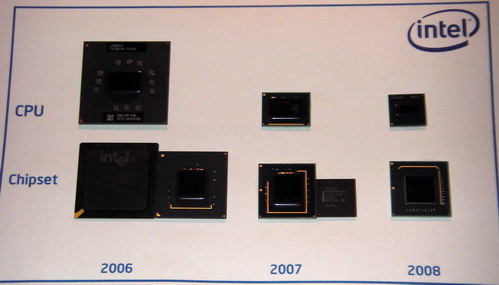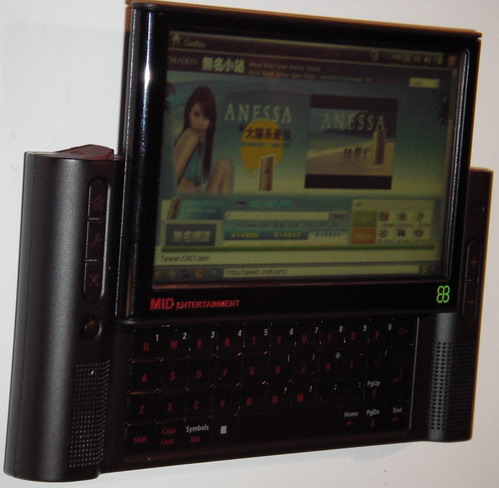Yesterday afternoon Intel has a press briefing about a new platform that ends up in between a UMPC and a smart phone, the MID or Mobile Internet Device. You might wonder what this is and when you actually get to see a retail product. Well, the first products are already appearing, but they're not true MIDs as they're not always connected to the internet.
Current MIDs are using the McCaslin platform that was announced at IDF in Beijing in April this year and are as such based on either an Intel A100 or A110 processor, the 945GU Express chipset with ICH7U. Several manufacturers have already announced devices and you might already have heard about the HTC Shift which is one of the more well known devices based on this new platform, but many other manufactures such as Asus, Fujitsu and Samsung (the Q1 Ultra) also have devices that will be available shortly.
But forget about now, these devices are all too big and clumsy and won't fit in your pocket, don't buy them, wait until next year instead if you want something smaller than a UMPC, but bigger than a smart phone, as this is when the Menlow platform arrives. If you look at the picture below, you'll see the reduction in the size of the CPU and chipset over three year's time, it's quite amazing how quick these things shrink.
The Menlow platform will allow for much smaller devices, but without losing any of the power from the McCaslin platform. Intel was talking about 1GHz CPU's with 4-5h battery life with wireless connectivity options compromising of a combination of Bluetooth, Wi-Fi, 3G/HSDPA and WiMAX as well as features such as integrated GPS on a PCB about twice the size of a playing card. This is still larger than the VIA Mobile-ITX platform we wrote about earlier, so it'll be interesting to see what happens in this space.
The Silverthorne CPU is based on 45nm technology and it's tiny, Intel showed a picture of it next to a Taiwanese NT$1 coin, about the size of a US 1 cent coin or a €20 cent coin. That's pretty tiny for a 1GHz CPU, but it's needed to get the thermals right on a small device. Intel claims that the Menlow platform will offer a 10 per cent performance increase over the current McCaslin platform at the same clock speed while reducing the thermals, package size and average power draw by four times. These are indeed impressive claims, but we'll have to wait for final products before we find out if it really is true.
There were several mockup devices and prototypes show, but a Finish company called Elektrobit had a working sample of its EB MIMD on display. This is a rather stylish looking device, altough the impressive thing is that it only took them seven weeks to built this sample based on the Menlow platform. Although this was a hand built sample, it's still something of a proof for how well integrated this new Intel platform is and how little R&D is needed to be done by the device manufacturers.
The Menlow platform will run either Windows XP, Vista or Linux. Intel is working together with Redflag and Ubuntu when it comes to Linux platforms for the Menlow platform. Several front ends will be available and these are being developed by Canonical and Pepper among others.
Intel's slogan for the MIDs is "The uncompromised internet in your pocket" although when asked about screen resolutions of these devices it turns out that the current generation only has 800x480 widescreen display, although Intel is looking into 1,024x600 displays as well. Considering more and more websites are being designed for 1,280x,1,024 screens, the follow on question with regards to how these sites would look on these lower resolution screens was answered by the fact that most companies would want to do sites suitable for these new screen resolutions.
If you consider how few companies that offer suitable sites for lower resolution screens on current handheld devices, one has to wonder how Intel is going to convince the big websites to make lower resolution versions of their websites for a new generation of devices. However, Intel showed some impressive demos of various video files playing in full screen on these devices without any frames being dropped. A Youtube video as well as a movie trailer was shown, although no mention of the wireless connectivity used was mentioned, but presumably it was Wi-Fi, so using a more mobile connectivity solution might not offer the same experience.
The other issue of the MID platform is that these devices are expected to retail for US$500 and upwards when they become available some time in the first half of 2008. Intel expect the price to drop below US$500 at a later stage, but this is quite a lot of money, even compared to what Intel referred to as "not a very smart" smart phone. Hopefully some of these devices will be subsidised by network providers, much as mobile phones are these days, as this is the only way these kinds of devices will have fast market penetration at this price point.
Intel's MID platform is an interesting solution to a problem that doesn't really exist, although, to be able to always connect to the internet, not matter where you are, can be very useful, especially if you're a journalist that has to cover trade shows and events around the world.


Print this page

Computex 07: The full internet in your pocket
Published in
News
Intel talks MID's

Computex 07: The full internet in your pocket
